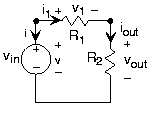| << Chapter < Page | Chapter >> Page > |
A circuit connects circuit elements together in a specific configuration designed to transform the source signal(originating from a voltage or current source) into another signal—the output—that corresponds to the currentor voltage defined for a particular circuit element. A simple resistive circuit is shown in [link] . This circuit is the electrical embodiment of a system having its input provided by a source system producing .



To understand what this circuit accomplishes, we want to determine the voltage across the resistor labeled by its value . Recasting this problem mathematically, we need to solve some setof equations so that we relate the output voltage to the source voltage. It would be simple—a little too simple at this point—if we could instantly write down theone equation that relates these two voltages. Until we have more knowledge about how circuits work, we must write a set ofequations that allow us to find all the voltages and currents that can be defined for every circuitelement. Because we have a three-element circuit, we have a total of six voltages and currents that must be either specifiedor determined. You can define the directions for positive current flow and positive voltage drop any way you like . Once the values for the voltages and currents are calculated, they may be positive or negative according to your definition.When two people define variables according to their individual preferences, the signs of their variables may not agree, but current flow andvoltage drop values for each element will agree. Do recall in defining your voltage and current variables that the v-i relations for the elements presume that positive current flow is in the samedirection as positive voltage drop. Once you define voltages and currents, we need six nonredundant equations to solve for thesix unknown voltages and currents. By specifying the source, we have one; this amounts to providing the source's v-i relation. The v-i relations for the resistors give us two more. We are only halfway there;where do we get the other three equations we need?
What we need to solve every circuit problem are mathematical statements that express how the circuit elements are interconnected. Said another way, we need the laws that govern theelectrical connection of circuit elements. First of all, the places where circuit elements attach to each other are called nodes . Two nodes are explicitly indicated in [link] ; a third is at the bottom where the voltage source and resistor are connected. Electrical engineers tend to draw circuit diagrams—schematics— in a rectilinearfashion. Thus the long line connecting the bottom of the voltage source with the bottom of the resistor is intended to make thediagram look pretty. This line simply means that the two elements are connected together. Kirchhoff's Laws , one for voltage and one for current , determine what a connection among circuit elements means. Theselaws are essential to analyzing this and any circuit. They are named for Gustav Kirchhoff , a nineteenth century German physicist.

Notification Switch
Would you like to follow the 'Fundamentals of electrical engineering i' conversation and receive update notifications?